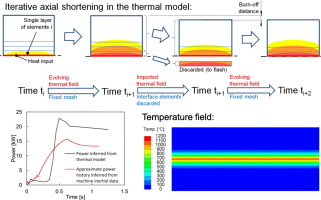当前位置:
X-MOL 学术
›
Mater. Des.
›
论文详情
Our official English website, www.x-mol.net, welcomes your
feedback! (Note: you will need to create a separate account there.)
Thermal modelling of linear friction welding
Materials & Design ( IF 7.6 ) Pub Date : 2018-10-01 , DOI: 10.1016/j.matdes.2018.06.043 P. Jedrasiak , H.R. Shercliff , A.R. McAndrew , P.A. Colegrove
Materials & Design ( IF 7.6 ) Pub Date : 2018-10-01 , DOI: 10.1016/j.matdes.2018.06.043 P. Jedrasiak , H.R. Shercliff , A.R. McAndrew , P.A. Colegrove

|
Abstract This paper presents a finite element thermal model for linear friction welding applied to an instrumented weld in Ti6Al4V. The power at the weld interface was estimated from the measured transverse velocity and the cyclic machine load. This was compared with the power history reverse-engineered from thermocouple data. A simple analytical model captured the lateral distribution of heat input at the interface, while geometry changes and heat loss due to the expulsion of flash were included using a sequential step-wise technique, removing interface elements one layer at a time at discrete intervals. Comparison of predicted and experimental power showed a 20% discrepancy, attributed to uncertainty in the power estimate from force and displacement data, and sensitivity to the precision of locating the thermocouples. The thermal model is computationally efficient, and is sufficiently accurate for application to a new thermomechanical modelling approach, developed in a subsequent paper [1].
中文翻译:

线性摩擦焊的热建模
摘要 本文提出了一种线性摩擦焊接的有限元热模型,该模型应用于 Ti6Al4V 仪表焊缝。焊接界面处的功率是根据测得的横向速度和循环机器负载估算的。这与从热电偶数据逆向工程的功率历史进行了比较。一个简单的分析模型捕获了界面处热量输入的横向分布,同时使用顺序逐步技术包括几何形状变化和由于闪光排出而导致的热量损失,以离散间隔一次去除一层界面元素。预测功率和实验功率的比较显示出 20% 的差异,这归因于力和位移数据的功率估计的不确定性,以及对热电偶定位精度的敏感性。
更新日期:2018-10-01
中文翻译:

线性摩擦焊的热建模
摘要 本文提出了一种线性摩擦焊接的有限元热模型,该模型应用于 Ti6Al4V 仪表焊缝。焊接界面处的功率是根据测得的横向速度和循环机器负载估算的。这与从热电偶数据逆向工程的功率历史进行了比较。一个简单的分析模型捕获了界面处热量输入的横向分布,同时使用顺序逐步技术包括几何形状变化和由于闪光排出而导致的热量损失,以离散间隔一次去除一层界面元素。预测功率和实验功率的比较显示出 20% 的差异,这归因于力和位移数据的功率估计的不确定性,以及对热电偶定位精度的敏感性。











































 京公网安备 11010802027423号
京公网安备 11010802027423号